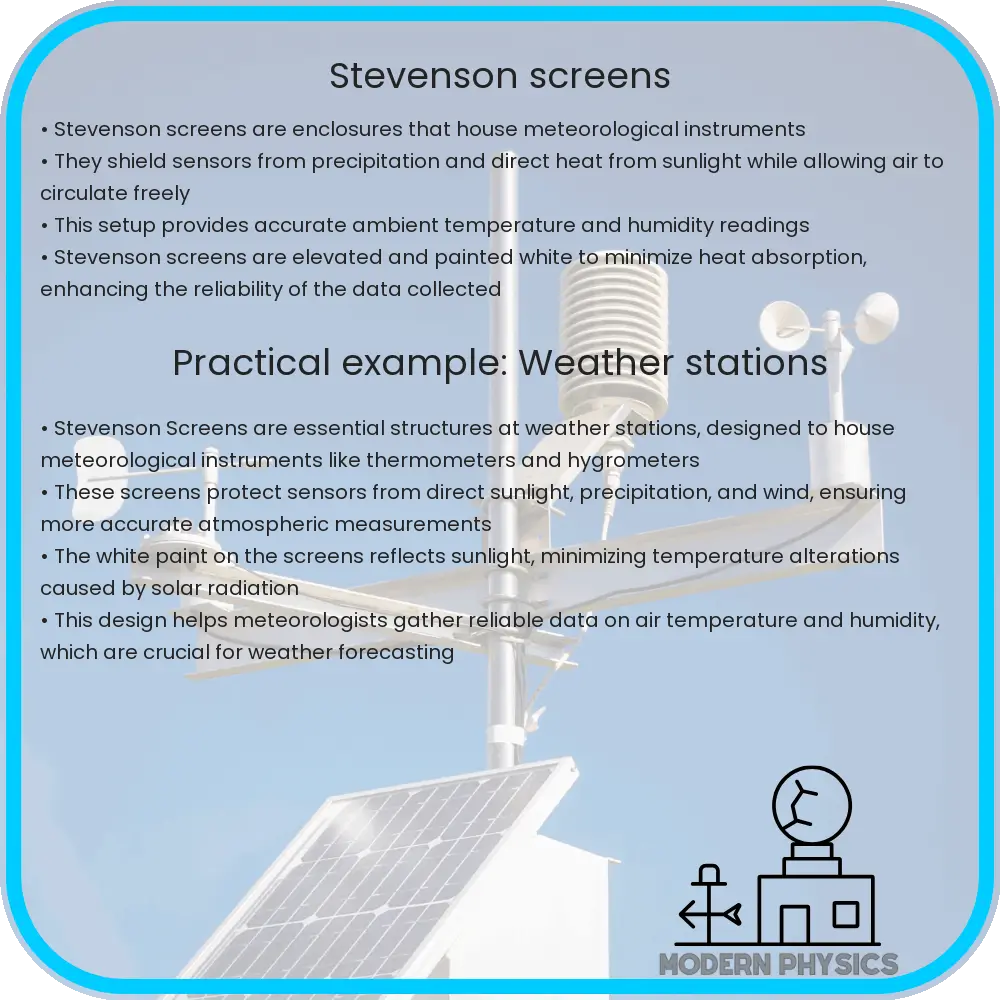Stevenson screens are structures designed to house and protect meteorological instruments, ensuring accurate atmospheric measurements.

Introduction to Stevenson Screens
Stevenson screens, also known as instrument shelters, are an essential component in meteorological measurements. They are specially designed structures that house meteorological instruments, such as thermometers, hygrometers, and barometers. The primary purpose of a Stevenson screen is to provide a standardized environment in which atmospheric measurements can be taken, ensuring accuracy and comparability of data over time and across different locations.
Design Features of Stevenson Screens
The design of Stevenson screens is carefully considered to maximize measurement accuracy while protecting sensitive meteorological instruments from the elements. Key features include:
- Ventilation: Screens have louvers or slatted sides to allow air to circulate freely around the instruments while shielding them from direct sunlight and precipitation.
- Material: Traditionally made from wood, modern Stevenson screens are often constructed from other materials like plastic or metal that can better withstand the elements without affecting the measured variables.
- Color: They are painted white to reflect sunlight and minimize solar heat gain which could skew temperature readings.
- Elevation: The screen is usually mounted on legs, raising it above the ground to prevent heat radiated from the surface from affecting the instruments.
Importance of Accuracy in Meteorological Measurements
Accuracy in meteorological data is vital for a wide range of applications, from daily weather forecasting to climate research. Inaccurate data can lead to incorrect predictions and misinform climate studies. Stevenson screens play a critical role here by ensuring that the environmental conditions impacting the instruments are as consistent as possible.
For instance, protecting instruments from direct sunlight is crucial because exposure can cause thermometers to record higher temperatures, thus misrepresenting the actual air temperature. Similarly, proper air circulation is essential to avoid moisture buildup, which can affect humidity readings.
Applications in Meteorology
Stevenson screens are ubiquitous in meteorological stations around the world. They are a fundamental part of the infrastructure for weather monitoring and play a pivotal role in:
- Weather Prediction: Data collected from instruments housed in Stevenson screens feeds into models that predict weather conditions.
- Climate Research: Long-term data collection using standardized Stevenson screens provides reliable records that help scientists understand climate patterns and variability.
- Agricultural Planning: Accurate local climate data aids farmers in making informed decisions about crop planting, irrigation, and harvesting.
By ensuring the consistency and accuracy of meteorological data, Stevenson screens not only support day-to-day weather forecasting but also underpin long-term climate monitoring and research efforts globally.
Maintenance and Challenges
While Stevenson screens are designed to optimize meteorological measurements, maintaining their accuracy over time requires regular upkeep. The white paint must be refreshed periodically to ensure it continues to reflect sunlight effectively. Similarly, the structural integrity of the screen needs to be checked to prevent any damage that might compromise the shelter’s protective qualities. Furthermore, the location of the screen must be periodically evaluated to ensure that it remains free from obstructing flora or artificially heated surfaces which could skew readings.
Innovations in Stevenson Screen Design
Recent advancements in technology and materials have led to improvements in the design and functionality of Stevenson screens. For example, some modern versions use automated sensors and data loggers that can transmit readings remotely, reducing the need for manual data collection. Additionally, new materials that are more resistant to weathering and decay have been incorporated, extending the lifespan of these crucial meteorological tools. These innovations help ensure that Stevenson screens continue to provide reliable data in an ever-changing environment.
Conclusion
Stevenson screens are a cornerstone of meteorological science, from daily weather forecasting to crucial climate research. Their design features, such as ventilation, appropriate materials, and specific color, are meticulously planned to ensure the accuracy of the data collected by housed instruments. With the advancement of technology, these screens have evolved to become even more efficient and reliable over time. Maintenance plays a vital role in the functionality of these screens, highlighting the importance of regular checks and updates. Through their continued use and development, Stevenson screens maintain their place as indispensable tools in meteorological studies, helping us to better understand and predict the complexities of the Earth’s atmosphere.
